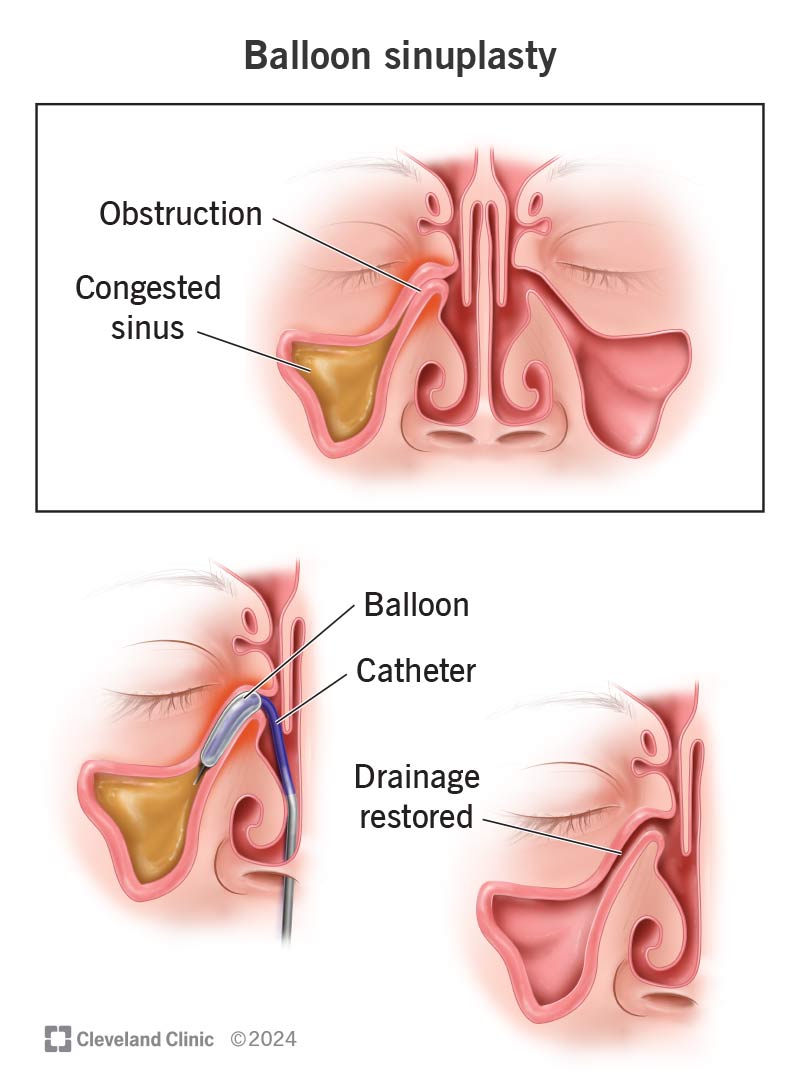Balloon sinuplasty is a minimally invasive way to treat chronic sinusitis. During the procedure, a healthcare provider slowly inflates a tiny balloon within your sinus cavity. The balloon enlarges the space, so the mucus that’s built up in your sinuses can drain better. You may need this treatment if medications haven’t improved your symptoms.
Advertisement
Cleveland Clinic is a non-profit academic medical center. Advertising on our site helps support our mission. We do not endorse non-Cleveland Clinic products or services. Policy

Balloon sinuplasty is a minimally invasive treatment for sinusitis, also called chronic sinusitis. During the procedure, a healthcare provider gently inserts and then inflates a tiny balloon in your sinus cavity. As it gets bigger, it enlarges your sinuses, making it easier to drain any mucus that’s built up.
Advertisement
Cleveland Clinic is a non-profit academic medical center. Advertising on our site helps support our mission. We do not endorse non-Cleveland Clinic products or services. Policy
Some people who have chronic sinus symptoms may be treated with balloon sinuplasty instead of endoscopic sinus surgery (ESS).
Millions of people have chronic sinusitis. It can cause pesky, persistent symptoms like a runny nose and nasal congestion. Medical treatments, including antibiotics, can ease most people’s symptoms. But if your symptoms last more than 12 weeks, your healthcare provider might recommend balloon sinuplasty or endoscopic sinus surgery. Both procedures treat sinusitis without requiring cuts in or around your nose.
Healthcare providers have used balloon sinuplasty since 2005. The treatment has become increasingly popular, as providers can perform the procedure at medical offices as well as in hospitals.
Before you have balloon sinuplasty, your healthcare provider will use computed tomography (CT) scans to confirm balloon sinuplasty is an appropriate treatment for your condition.
You can get balloon sinuplasty in a hospital operating room or a medical office. Beforehand, you’ll receive general anesthesia or be under conscious sedation. Conscious sedation blocks pain but allows you to stay awake during the procedure.
If you’re in an operating room, you’ll lie on an operating table. Your healthcare provider will:
Advertisement
If you’re in a medical office, you’ll sit in a reclining exam chair. Your provider will:
No, balloon sinuplasty usually isn’t painful. Most people who have balloon sinuplasty report feeling a sense of pressure in their nose during the procedure.
You may notice some discomfort in your nose after the procedure. Over-the-counter pain relievers may help you feel better. Your healthcare provider will explain which medications to use and avoid after balloon sinuplasty.
You’ll stay at the hospital or medical office until you feel comfortable leaving. Most healthcare providers recommend you ask someone to drive you to and from your appointment. Your provider might recommend a schedule of follow-up appointments and tests that looks like this:
Balloon sinuplasty is a safe and minimally invasive way to treat chronic sinusitis. Studies show that the results are long-lasting. Compared to sinus surgery, balloon sinuplasty may lead to a faster recovery with less pain after the procedure.
Few people who have balloon sinuplasty report complications. Still, as with any procedure, they can occur. Complications after balloon sinuplasty may include:
Advertisement
Your symptoms might come back. If they do, you may need another balloon sinuplasty or a different treatment, like endoscopic sinus surgery.
You might need to rest at home for 24 to 48 hours after your balloon sinuplasty. Your healthcare provider might recommend the following steps to help you recover:
Within the next week or two, most people are on track toward a full recovery and able to resume their routines.
Most people who have balloon sinuplasty notice some bloody drainage from their noses. That’s completely normal. Call your healthcare provider if your nose bleeds a lot and you can’t control the bleeding.
Ask your provider about other symptoms to look out for that may be a sign of a complication.
A balloon sinuplasty can ease sinusitis symptoms that won’t let up. You don’t have to live with a nose that won’t stop running. Or a nose so stuffed with gunk that you can barely breathe. Or pain that makes your face ache. If conservative treatments like medications don’t work, a balloon sinuplasty may help. Your healthcare provider can explain whether this procedure is right for you.
Advertisement
Constant stuffiness, sinus pressure and pain can wear you out. But you don’t have to live with it. Cleveland Clinic sinus surgery experts can help you get relief.

Last reviewed on 12/20/2024.
Learn more about the Health Library and our editorial process.